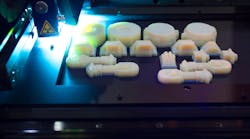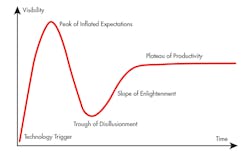Download this article as a .PDF
When it comes to 3D printing for production parts, it’s no mystery why aerospace and defense companies are leading the pack (with medical device firms a distant third). They’ve sunk the most money into the R&D behind it, and they have customers for whom performance is paramount and price is seemingly no object.
For other industries, 3D printing is still mainly used for prototyping, if at all. Companies in most industries are waiting to see how the various technologies and capabilities shake out, and which might be suitable for making production parts that meet their needs and contribute to the bottom line. For example, there already an alphabet soup of different 3D printing methods (DLS, FDM, CLIP, SLA, DLP, SLM, EBM, and LOM, plus an array of “jetting” versions and various hybrids), with new, potentially game-changing ones always popping up on the horizon. They all have different strengths and weaknesses (speed, cost, resolution, surface finish, part strength, build volume, and materials, to name a few). And speaking of materials, 3D printers can use Nylon (polyamides), ABS, resins, stainless steel, Inconel, gold, silver, titanium, gypsum, and ceramics. The material questions add another layer of complexity for companies contemplating 3D-printed production parts.
So let’s see where 3D printing production parts might fall on the Hype Cycle.
The Hype Cycle is a graph of visibility (aka hype or public interest) versus time and was developed by Gartner Inc., an information technology research and advisory company. It’s “a graphic representation of the maturity and adoption of a technology or applications, and how it is potentially relevant to solving real business problems and exploiting new opportunities,” according to Gartner.
The graph is intuitive to engineers with a few years of experience under their belts. Everyone has seen a technology blast into the limelight with promises of changing the world…only to then dive back into the lab for more development, testing, and trials. Some ideas never go beyond this stage; they disappear into the Trough of Disillusionment (think cold fusion, fuzzy logic, or the Segway). But many climb out of the trough and slowly up the Slope of Enlightenment into the mainstream—the Plateau of Productivity—and become part of everyday engineering and manufacturing.
So if you plot 3D printing for production on the Hype Cycle, it would likely fall a fifth to a quarter of the way up the Slope of Enlightenment. (The Hype Cycle is not an exact science.)
There are a few hurdles along that slope that are stretching the time until 3D printed production parts are widespread among industries. These include the aforementioned cornucopia of different 3D printing methods, capabilities, and materials. Companies can be confused as to which path to take.
Another major hurdle is the lack of expertise when it comes to designing for 3D printing (DFTDP?). Not many engineers are well versed in all the intricacies and idiosyncrasies of 3D printing. Many of the technology’s rules of thumb have yet to be discovered, and engineering schools aren’t formally teaching them. (Unfortunately, not many engineering schools are teaching the finer points of traditional machining or manufacturing, either.) There are maker spaces outfitted with various 3D printers, but students rarely look to turn out production parts. Prototypes and one-offs are more common.
This isn’t unusual for a new crop of technologies, and it’s why service bureaus offer to redesign parts for clients purchasing 3D printing services. Those firms are acquiring the experience in knowing what works and how to gain an advantage when it comes to 3D printed production parts. Eventually that knowledge will spread, and the engineering community will know where 3D printing’s unique combination of strengths and capabilities lie.
It’s also possible that 3D printing will never be the best choice for manufacturing parts in volumes greater than 10,000. Building parts one layer at a time, with layers measured in thousandths of an inch, takes time.
It will be interesting to see how 3D printed production parts makes its way through the Hype Cycle.
I’d like to thank the experts that gave presentations on 3D printing at the recent ID&E Show in Cleveland: Cullen Hilken of 3Diligent, Greg Thompson of Proto Labs, and Kent Firestone and Bob Wolters of Stratasys Direct Manufacturing. Their insights into 3D printing were invaluable in putting this together.


